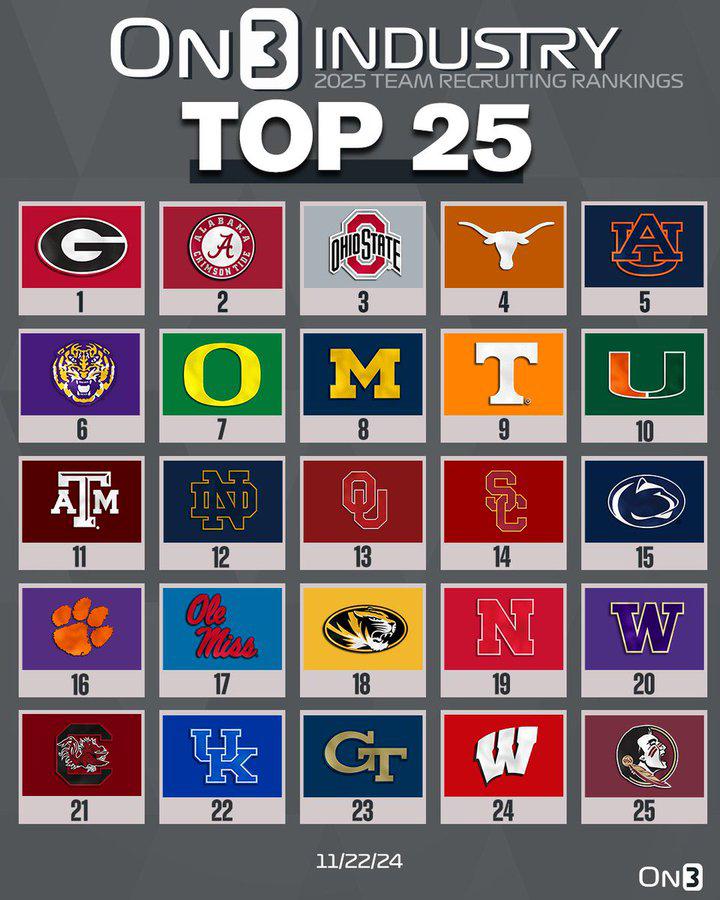The college football recruiting landscape has undergone seismic shifts over the past few years, and the latest On3 Industry Team Recruiting Rankings reflect the culmination of talent evaluation, program strategy, and the ever-evolving dynamics of NIL (Name, Image, Likeness) deals. These rankings, a benchmark for measuring recruiting success, not only highlight a program’s ability to attract top-tier athletes but also provide a glimpse into the future of college football powerhouses.
The On3 Industry Team Recruiting Rankings are built on a comprehensive evaluation system that synthesizes data from multiple major recruiting services, including 247Sports, Rivals, and ESPN. By averaging the scores from these platforms, On3 has created an accurate and unified standard for assessing a team’s recruiting class. This method ensures a well-rounded evaluation of every player and offers fans, analysts, and coaches an insightful tool to measure a program’s recruiting prowess.
The rankings are far more than a snapshot of high school stars committing to major programs. They act as predictors of a team’s potential on the field, revealing where the best talent is concentrated. Teams ranked at the top are usually those that combine player development systems, proven coaching ability, and effective use of modern recruiting tactics, including NIL opportunities. For programs like Alabama, Georgia, and Ohio State, perennial leaders in the rankings, these factors are deeply ingrained into their recruiting culture.
These schools consistently recruit five-star athletes capable of impacting their respective teams immediately. However, the rankings also highlight programs that have succeeded in maximizing the potential of lesser-known prospects. For example, schools like Utah and Kansas State have consistently developed three- and four-star recruits into NFL-level players, showcasing their ability to overachieve based on rankings alone.
The latest update to the On3 Industry Team Recruiting Rankings has spotlighted a few surprise entries among the elite programs. Schools such as Texas A&M, Oregon, and Florida State have made significant gains, propelled by coaching stability and aggressive recruiting strategies. Programs like these are capitalizing on fertile recruiting grounds, strong brand identities, and significant NIL investments to challenge traditional powerhouses.
A standout example is Colorado, led by Deion Sanders. While they may not yet crack the top 10, the program’s ability to draw in top-tier talent amid a rebuilding phase showcases the power of modern media influence and charisma-driven recruiting. Coach Sanders’ presence has created momentum that could catapult Colorado higher in future rankings if the trend continues.
Another key feature of the On3 Rankings is how they integrate the transfer portal into the equation. Unlike traditional high school recruiting rankings, the inclusion of transfers provides a more accurate reflection of a team’s immediate potential. Programs like USC and Florida have effectively leveraged the portal to bolster their rosters with proven college talent, enhancing their competitiveness while simultaneously improving their rankings.
The NIL era has added a new layer of complexity to recruiting. Top players are not only looking for programs that align with their athletic goals but also those that can provide lucrative NIL opportunities. Programs with strong alumni networks and partnerships are increasingly able to secure commitments from blue-chip recruits, further elevating their rankings.
What makes the On3 Industry Team Recruiting Rankings so powerful is their ability to predict future team success. Programs that consistently recruit top talent tend to dominate conference championships, make frequent College Football Playoff appearances, and send waves of players to the NFL. However, sustained success requires more than just recruiting star players. Coaching, culture, and player development remain critical factors in converting raw talent into championship-winning teams.
Schools like Georgia and Michigan are exemplars in this regard. Both programs have been able to not only recruit effectively but also develop their talent pools into cohesive, dominant units on the field. Their ability to translate high rankings into on-field success makes them benchmarks for other programs looking to replicate their models.
The On3 Industry Team Recruiting Rankings are more than just numbers on a page—they represent the future of college football. They reflect not only the current state of recruiting but also provide a roadmap for where the sport is heading. As NIL continues to reshape the recruiting landscape and the transfer portal gains importance, these rankings will remain an essential tool for fans, analysts, and coaches alike.
The updated rankings also serve as a call to action for programs seeking to climb the ranks. It’s not just about acquiring talent; it’s about fostering an environment that allows players to maximize their potential, contribute to team success, and ultimately achieve their goals on and off the field. For fans, the rankings add another layer of excitement to the sport, setting the stage for rivalries, breakout stars, and future legends.
With their ability to combine hard data, expert analysis, and a forward-looking perspective, the On3 Industry Team Recruiting Rankings continue to establish themselves as a trusted source for understanding the evolving dynamics of college football recruiting.

 Arne Slot: “It was the best game of football I was ever involved in”. “I don’t have the history like Liverpool, as a manager.readmore in comments section…
Arne Slot: “It was the best game of football I was ever involved in”. “I don’t have the history like Liverpool, as a manager.readmore in comments section…